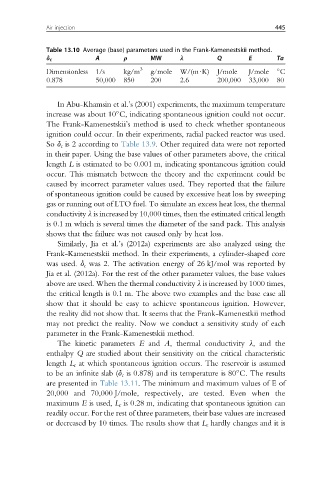Page 481 - Enhanced Oil Recovery in Shale and Tight Reservoirs
P. 481
Air injection 445
Table 13.10 Average (base) parameters used in the Frank-Kamenestskii method.
d c A r MW l Q E Ta
Dimensionless 1/s kg/m 3 g/mole W/(m$K) J/mole J/mole C
0.878 50,000 850 200 2.6 200,000 33,000 80
In Abu-Khamsin et al.’s (2001) experiments, the maximum temperature
increase was about 10 C, indicating spontaneous ignition could not occur.
The Frank-Kamenestskii’s method is used to check whether spontaneous
ignition could occur. In their experiments, radial packed reactor was used.
So d c is 2 according to Table 13.9. Other required data were not reported
in their paper. Using the base values of other parameters above, the critical
length L is estimated to be 0.001 m, indicating spontaneous ignition could
occur. This mismatch between the theory and the experiment could be
caused by incorrect parameter values used. They reported that the failure
of spontaneous ignition could be caused by excessive heat loss by sweeping
gas or running out of LTO fuel. To simulate an excess heat loss, the thermal
conductivity l is increased by 10,000 times, then the estimated critical length
is 0.1 m which is several times the diameter of the sand pack. This analysis
shows that the failure was not caused only by heat loss.
Similarly, Jia et al.’s (2012a) experiments are also analyzed using the
Frank-Kamenestskii method. In their experiments, a cylinder-shaped core
was used. d c was 2. The activation energy of 26 kJ/mol was reported by
Jia et al. (2012a). For the rest of the other parameter values, the base values
above are used. When the thermal conductivity l is increased by 1000 times,
the critical length is 0.1 m. The above two examples and the base case all
show that it should be easy to achieve spontaneous ignition. However,
the reality did not show that. It seems that the Frank-Kamenestkii method
may not predict the reality. Now we conduct a sensitivity study of each
parameter in the Frank-Kamenestskii method.
The kinetic parameters E and A, thermal conductivity l, and the
enthalpy Q are studied about their sensitivity on the critical characteristic
length L c at which spontaneous ignition occurs. The reservoir is assumed
to be an infinite slab (d c is 0.878) and its temperature is 80 C. The results
are presented in Table 13.11. The minimum and maximum values of E of
20,000 and 70,000 J/mole, respectively, are tested. Even when the
maximum E is used, L c is 0.28 m, indicating that spontaneous ignition can
readily occur. For the rest of three parameters, their base values are increased
or decreased by 10 times. The results show that L c hardly changes and it is

